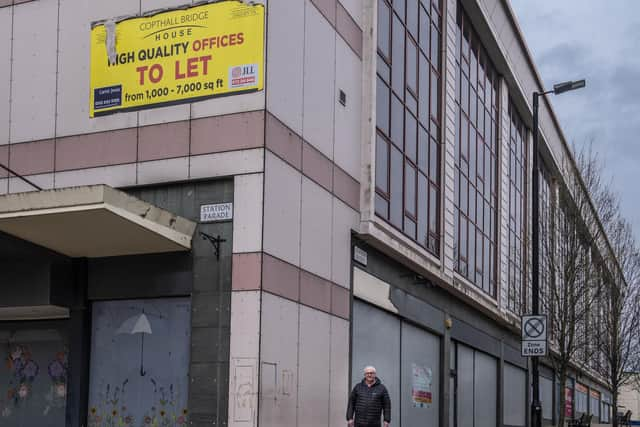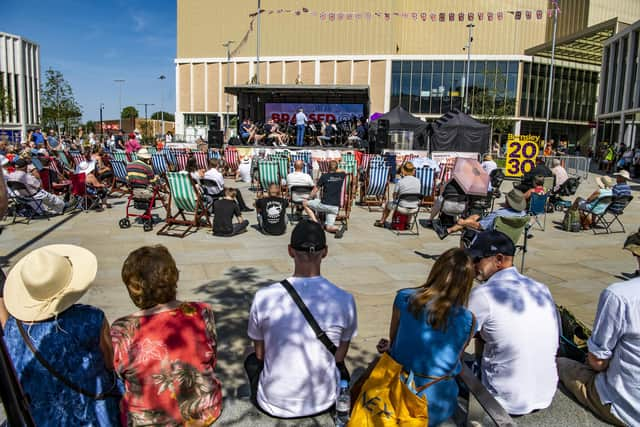Yorkshire planning consultant on our changing high streets, Barnsley's redevelopment and why variety is key
“Then there was the development of out-of-town retailing and retail parks with supermarkets.
"Latterly, it tends to be online shopping that has led to major change to the extent that many of the outer town retail parks which had the biggest impact on the town centres, even those have struggled.
Advertisement
Hide AdAdvertisement
Hide Ad"It’s not uncommon now to go to some of the big retailers and see an item on display but if you actually want to buy it, you have to order it to be delivered to your home or to collect in store in a few days time.”


Bob, who lives just outside of Harrogate, is a director at DPP, an independent national planning consultancy.
The firm works with both public and private sector clients on planning residential and employment developments, as well as education, retail and leisure schemes, and renewable energy projects.
As high streets feel the heat of the country’s cost-of-living crisis – and on the back too, of a global pandemic - Bob tells The Yorkshire Post that variety is key.
Advertisement
Hide AdAdvertisement
Hide Ad"It’s going to be about not just retail but also giving people other reasons to go to town centres,” he says. “It’s going to be leisure, medical drop in centres, just encouraging people to visit town centres as a place in themselves, a place to mingle and dwell by having a broader range of attractions."


He points to Barnsley as an example of a place where proactive steps have been taken to transform the town centre. Its multi-million The Glass Works development was opened in September 2021, a location for retail, leisure, learning and hospitality.
As well as attracting big brands such as Cineworld, Nandos, The Botanist and Superbowl, the development hosts a new-look library for the town and is home to a thriving market hall and food court packed with independent, local businesses.
A new public square connecting The Glass Works with the transport interchange and wider town centre has also become a hub of activity, recently hosting the Flavours Food Festival and soon to be at the heart of the one-day multi-venue music festival, Barnsley Live.
Advertisement
Hide AdAdvertisement
Hide Ad“Generally speaking, town centres are adapting,” Bob says. “Part of that has been down to Government relaxing planning controls in town centres to allow a broader range of activities to occur.
"But a lot has also been down to positive intervention and Barnsley is a good example of that. People are taking positive steps to improve the town centre and repurpose it for modern habits and trends.”
Another example of a Yorkshire centre “doing well” is Halifax, Bob claims. The town – and surrounding areas in Calderdale – have been beamed onto screens around the world with the likes of TV productions such as Happy Valley and Gentleman Jack and Halifax is capitalising on their success.
"I think people in Halifax are doing a lot to increase its attraction as a centre,” Bob says, “on the back of exposure on television but also realising they have a fantastic asset in the Piece Hall. It’s become a fantastic outdoor music venue, with some amazing acts coming.”
Advertisement
Hide AdAdvertisement
Hide AdRetail and leisure however is only part of the picture. When former Prime Minister Boris Johnson’s Government published its Build Back Better High Streets Strategy in 2021, the plan set out a vision for town centres “where a mix of commercial and residential uses complement each other”.
"We strongly encourage more housing around high streets and there are likely to be many opportunities as we emerge from the pandemic, for example for good quality conversions of offices to homes,” said then Communities Secretary Robert Jenrick.
Having a greater residential population means shops and town centre facilities have a readily available market, Bob explains.
“That’s going to be important for a lot of town centres and it’s then about managing the interface between particularly the night-time activities like bars and restaurants and the resident population.”
Advertisement
Hide AdAdvertisement
Hide AdFor places worst-hit by the impact of the pandemic, residential schemes are especially valuable. “The areas which have suffered the most are the larger centres like, for example, central Leeds,” Bob says.
"I still don’t think the footfall there is remotely what it was pre-pandemic because a lot more people are spending a big chunk of the week working from home. So central Leeds will be helped with more of the residential schemes taking place.”
We’re also more likely to see more mixed-use developments, says Bob, who started his planning career in 1984 and has worked on development schemes all over the country.
A number of office blocks, for example, are likely be redeveloped for environmental reasons as part of the Government’s net-zero carbon agenda and the need for buildings to be more energy efficient.
Advertisement
Hide AdAdvertisement
Hide AdBob believes there will be countless examples of these being changed into multi-functional developments – with office space sat alongside homes or hospitality offerings.
Ultimately, when it comes to planning for the future, much is driven by market demand. “Most property in the UK is privately owned and it’s what future investors see as being the growth areas if you like and then being ahead of those trends,” Bob says.
"There has been a recognition for some time that probably retail floorspace is becoming less of an attraction factor whereas housing and to a degree leisure has a better return.”
